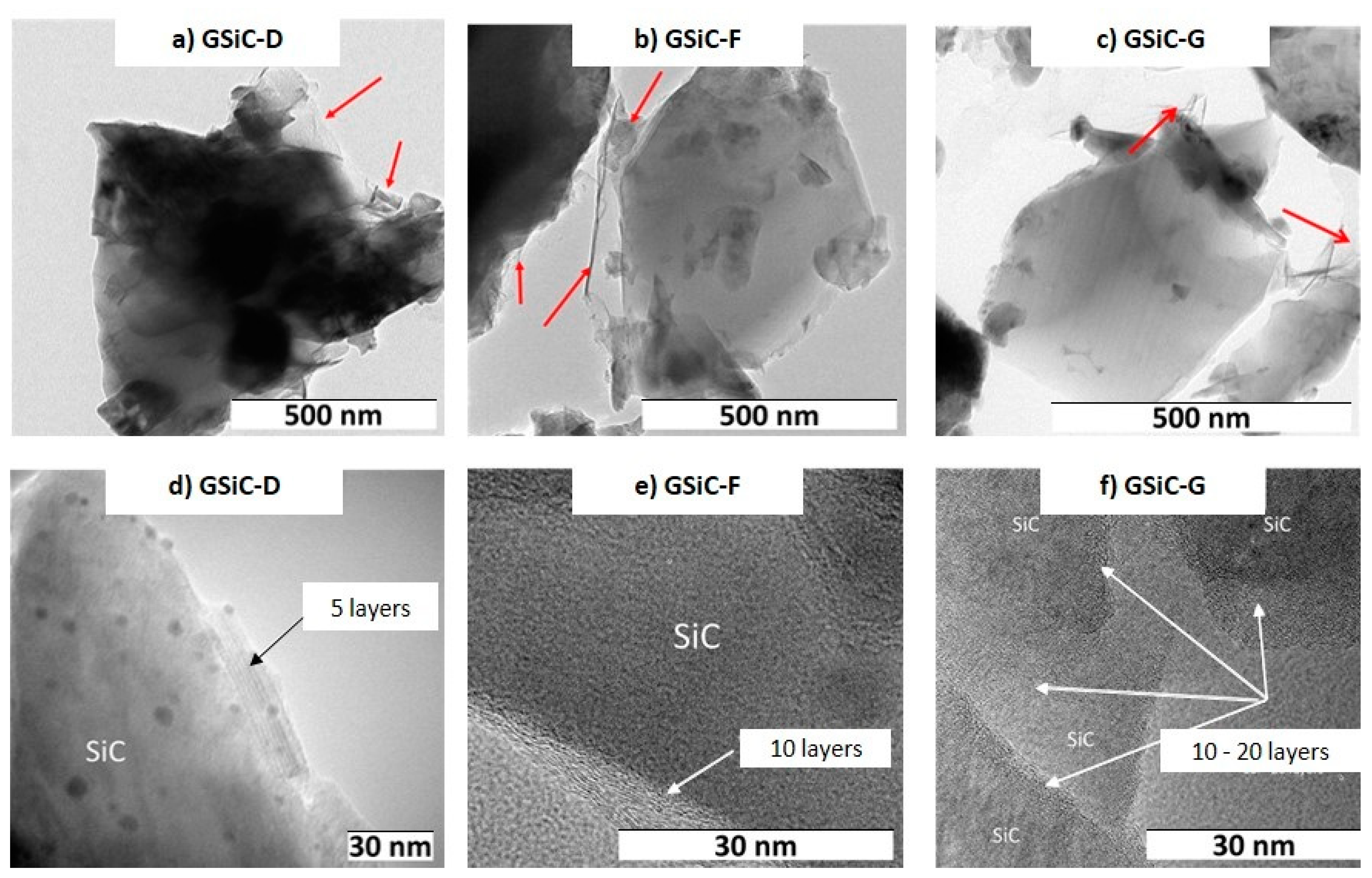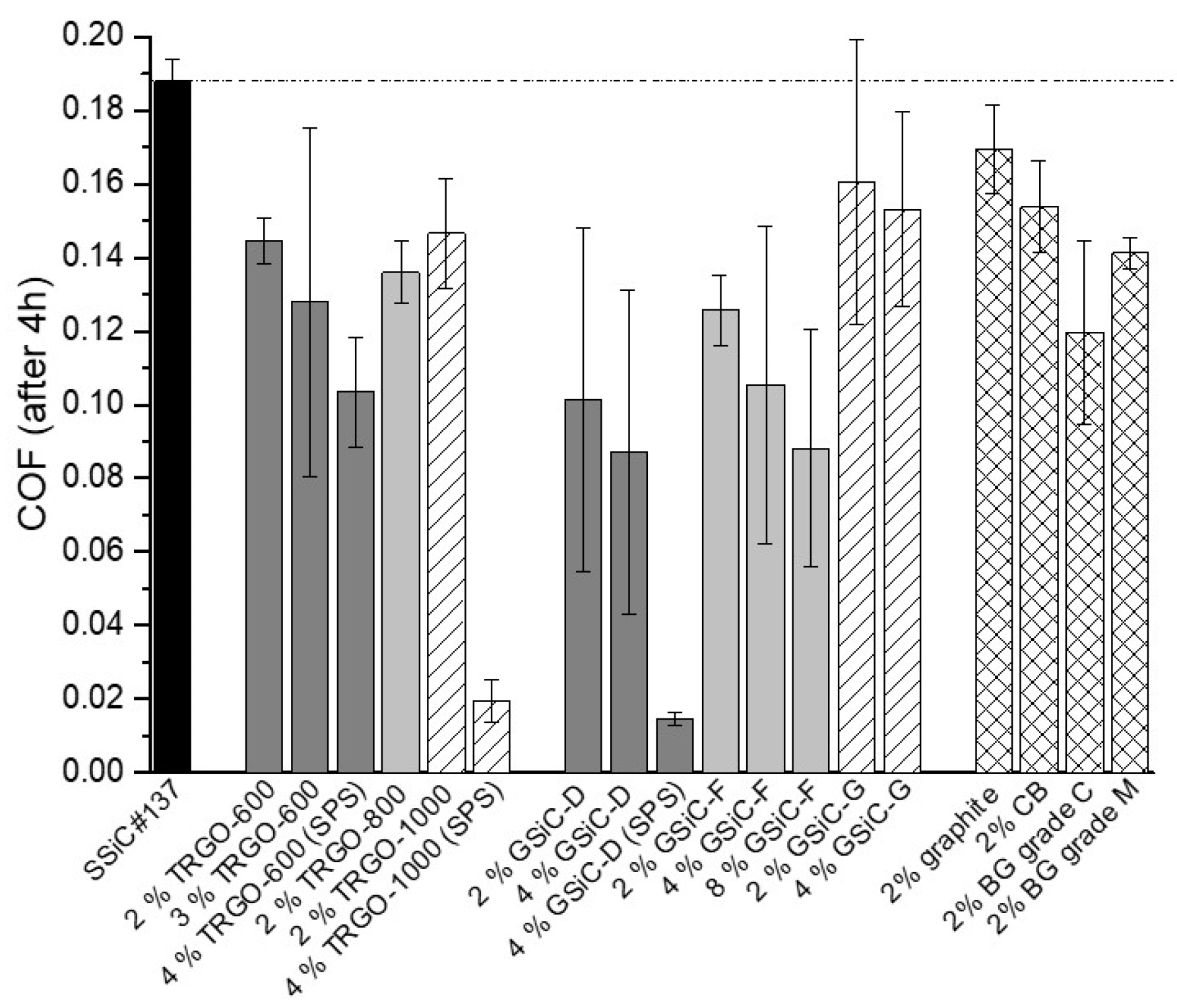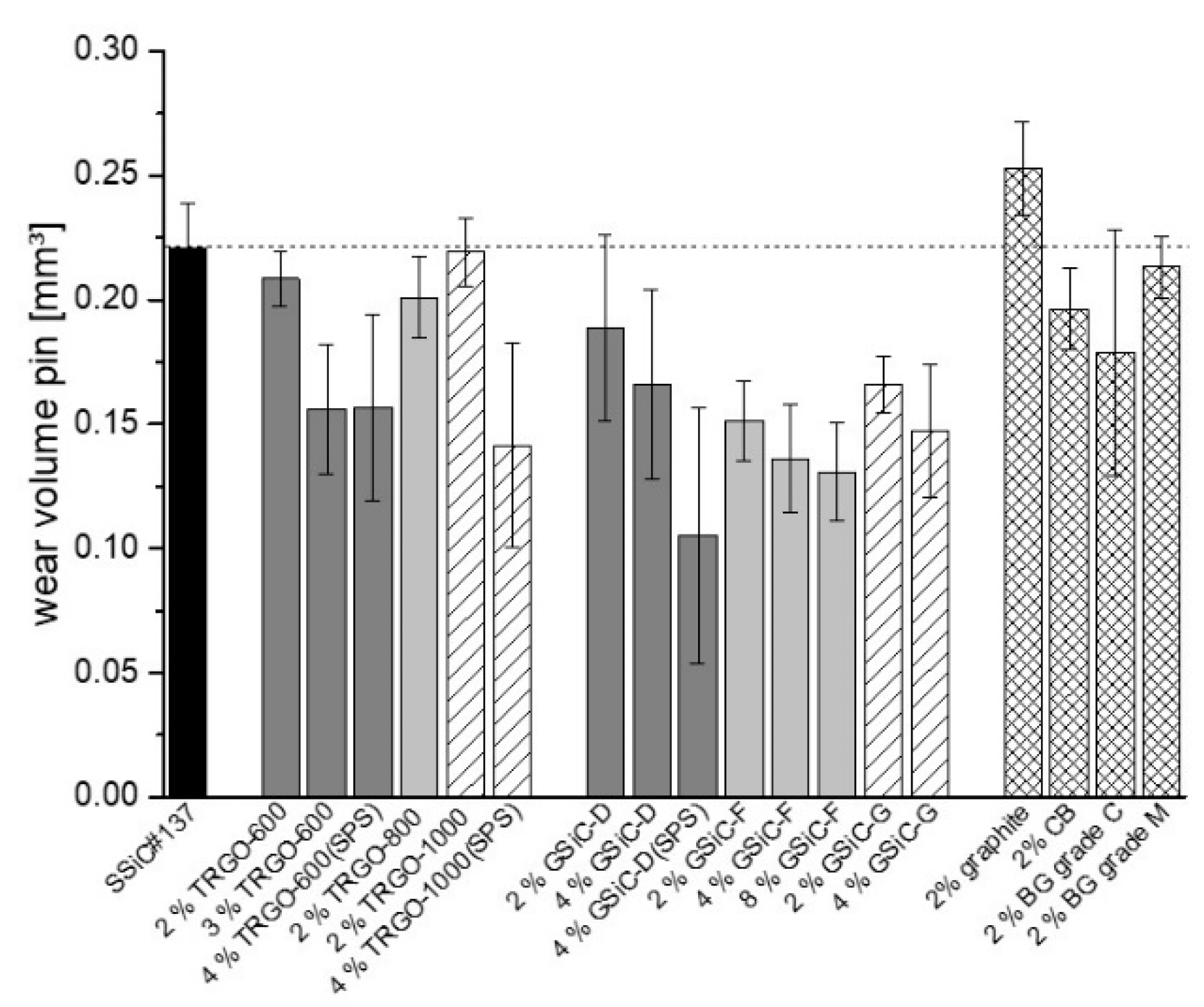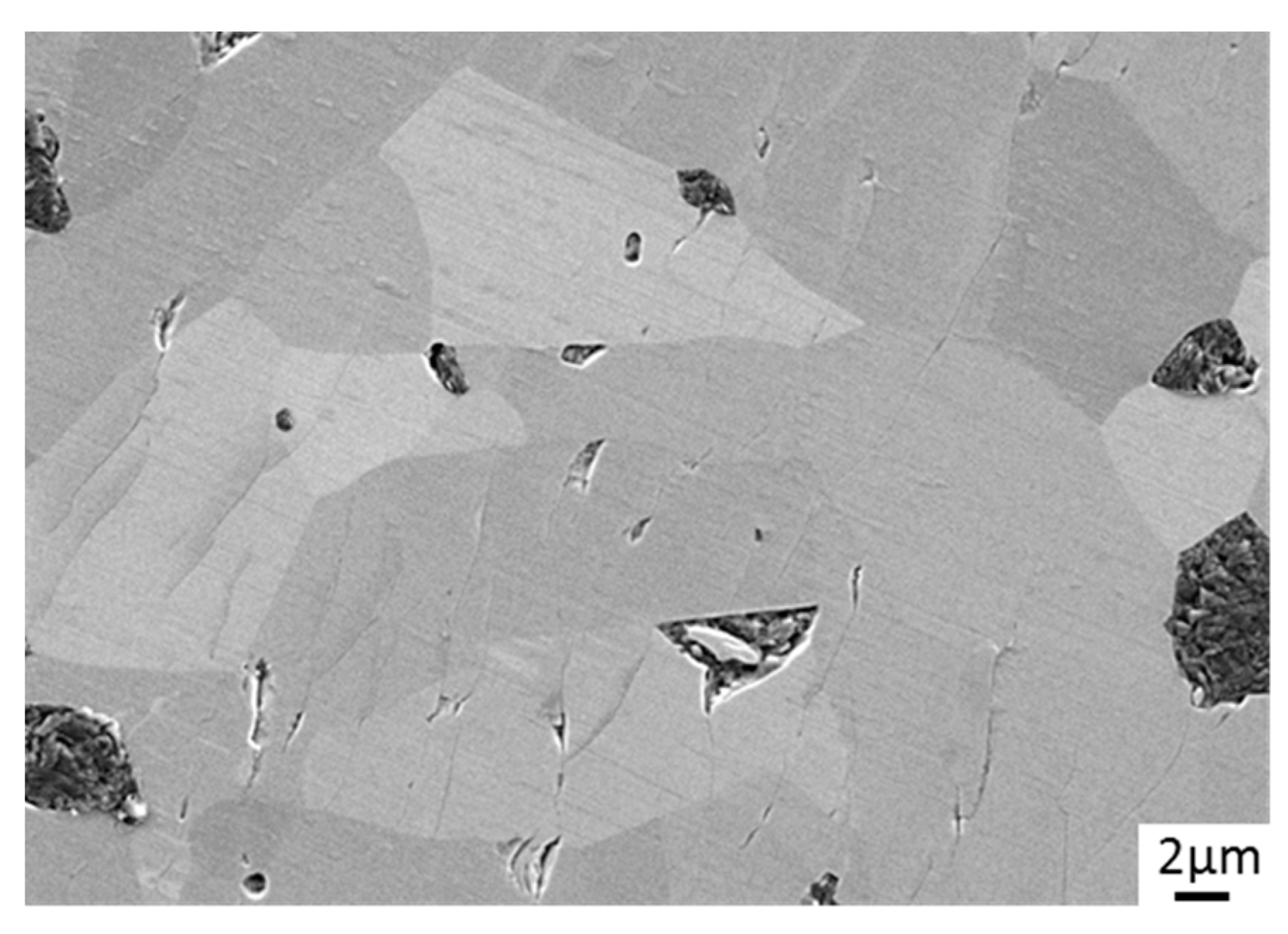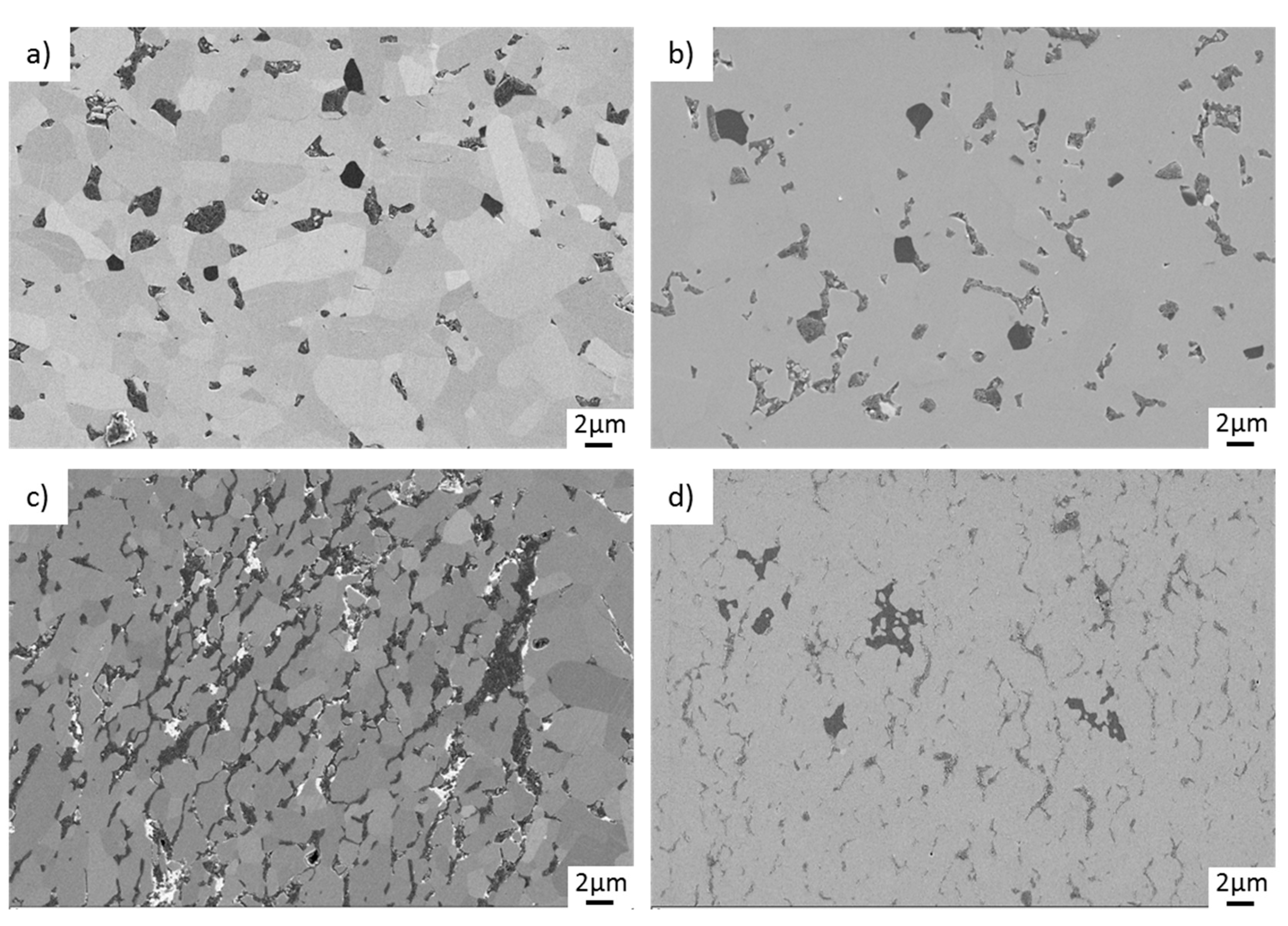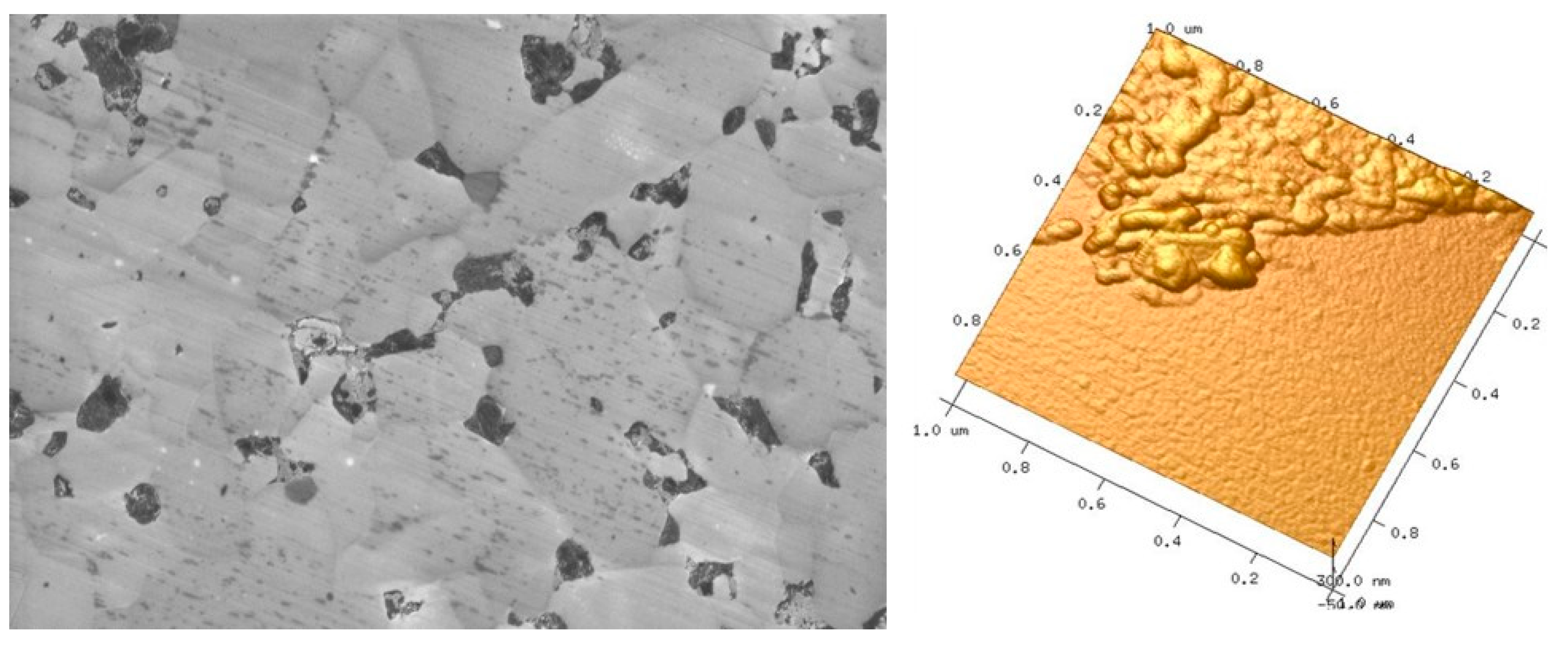1. Introduction
There is a strongly growing demand for highly wear-resistant and reliable ceramic materials that may be widely used in industrial applications and energy production. Reliability and efficiency of these components need to be improved by using high-performance ceramics with superior tribological and good mechanical properties. The main aim of this work is to develop novel, highly efficient materials on the basis of graphene-containing silicon carbide (SiC) nanocomposites and to demonstrate their suitability for technical applications such as slide bearings and face seals in aqueous media. SiC is an advanced ceramic material which is characterized by good mechanical and chemical properties as well as a superior resistance against wear [
1,
2]. For this reason, SiC ceramics are suitable for slide bearings and face seals, which are exposed to high tribological loads during operation. Nevertheless, there is a need to improve the friction and wear properties of these ceramic components and thereby enhance the reliability and the application range. The microstructural processes and wear mechanisms occurring in SiC under tribological loading in water lubrication have been extensively investigated by Presser et al. [
2]. Nevertheless, further investigations are necessary to predict the technical reliability, especially when the ceramic material is modified by carbon fillers. In this respect, various research projects have been carried out; however, mainly silicon nitride and alumina ceramics with carbonaceous fillers such as CNT [
3], graphene nanoplatelets (GNP) [
4] and reduced graphite oxide (rGO) [
5] were used. As summarized in recent reviews [
6,
7] the mechanical strength of silicon carbide ceramics may be only moderately increased by graphene and graphene-like platelets, whereas their fracture toughness is enhanced significantly. The strengthening mechanisms were considered to be crack deflection, crack bridging, tearing-open areas, relative sliding between graphene layers and crack branching. Some fewer publications also deal with tribological aspects. Here, however, the focus has been partly on other ceramic materials such as Si
3N
4 [
8,
9] and boron nitride [
10] ceramics in combination with graphene. These studies showed reduced friction and enhanced wear resistance; however, they were conducted under dry sliding, without any direct reference to real technical applications. Apart from the work on SiC/graphene ceramics, which focus on mechanical properties [
11,
12], fracture toughness [
13] and various sintering methods [
14], a few publications also discuss tribological properties under dry sliding conditions [
15] or under lubrication with isooctane [
16]. Though their wear resistance increases due to the formation of a surface-protecting layers, the friction behavior was not necessarily improved under dry conditions in comparison to unfilled SiC ceramics [
15,
17,
18].
As reported by Zhang et al. [
19], mechanochemically functionalized multilayer graphenes (MGs) affect the tribological behavior when used as fillers in SiC/MG nanocomposites. Under water-lubricated conditions, a noticeable reduction in friction and wear was achieved in comparison to standard SiC ceramics. It was found that MGs promote the formation of a wear protective surface layer.
The research work presented in this paper follows on from the studies of Zhang et al. [
19] investigating graphene-containing SiC nanocomposites. Here, the focus is set on both thermally reduced graphite oxide (TRGO) and graphene coated SiC (GSiC) as filler materials. Advantageously, TRGO is well-dispersible [
20] and can thus be distributed homogeneously in a ceramic matrix. In turn, GSiC can be produced quickly and easily and, thus, cost-effectively, which is a manufacturing advantage over established graphene production processes. It is also possible to use biobased raw materials for the production; thus, GSiC takes eco-friendly production and sustainability into account [
18]. In addition, both TRGO and GSiC can be manufactured with spark plasma sintering (SPS), a process which allows improved material properties to be achieved in shorter process times compared to conventional sintering processes [
21]. Complementary to the work of Zhang et al. [
19], the following study also examines the influence of different filler contents on the mechanical and tribological properties. The results are furthermore compared with the friction and wear behaviors of SiC ceramics containing commercially available carbon fillers.
2. Experimental Section
2.1. Synthesis of Thermally Reduced Graphite Oxide (TRGO)
Graphite oxide (GO) was prepared by oxidizing graphite via the Hummers method [
22]. Graphite (60 g, KFL99.5 graphite, AMG Graphite, Hauzenberg, Germany) and NaNO
3 (30 g) were suspended overnight in H
2SO
4 (95%, 1.4 L). At 0 °C, the KMnO
4 (180 g) was added in portions within 2 h. The suspension was then stirred for 2 more hours at room temperature. The dispersion was poured slowly on ice water (1.4 L), and H
2O
2 (5%, 200 mL) was added. The resulting mixture was filtered in a buechner funnel. The solid filter cake was rinsed several times with deionized H
2O (4 × 5 L) and concentrated HNO
3 (67%, 4 × 400 mL). The resulting sulphate and manganese impurities in the GO were largely removed by cross-flow filtration [
23]. After drying, approx. 80 g GO was obtained. The reaction product was dried for 7 days in a vacuum oven at 40 °C under reduced pressure and pulverized by a cryogenic mill (Retsch GmbH, Haan, Germany) (90 s, 25 s
−1) with nitrogen cooling. After milling, the drying procedure was repeated. The dry powder was reduced in a tube furnace at 600 °C, 800 °C and 1000 °C under nitrogen atmosphere (Typ RSR 120/750/11, Nabertherm, Lilienenthal, Germany) to yield a low-density powder. Accordingly, the produced thermally reduced graphite oxides are referred to as TRGO-600, TRGO-800 and TRGO-1000. To integrate the particles homogeneously into the ceramic matrix, TRGO dispersions (pH 10, 1 g/L) were produced in water. For this purpose, the dispersion was dispersed once in the high-pressure homogenizer (Panda NS1001L 2K, GEA Niro Soavi, Parma, Italy) at 1000 bar after an ultrasonic bath pretreatment (2 × 15 min) [
20].
2.2. Synthesis of Graphene Coated SiC (GSiC)
For the preparation of GSiC, three different precursors were used: dopamine (GSiC-D) [
24], furfuryl alcohol (GSiC-F) [
18] and glucose (GSiC-G) [
25,
26].
2.2.1. GSiC-D
Graphene-coated silicon carbide from dopamine (GSiC-D) was first prepared by dispersing SiC (18 g, PRC XF 13, 13 m2/g, d90 = 2 µm, QSIL Ingenieurkeramik, Frankenblick, Germany) in tris(hydroxymethyl)–aminomethane solution (80 mL; 100 mmol/L in H2O) using an ultrasonic bath (15 min). Then the solution of dopamine hydrochloride (2.00 g) was added to the tris(hydroxymethyl)–aminomethane solution (20 mL; 100 mmol/L in H2O). After stirring the reaction mixture for 72 h the water was removed by freeze-drying. The powder was mortared and carbonated in the tube furnace (Typ RSR 120/750/11, Nabertherm, Lilienenthal, Germany) in a nitrogen atmosphere. The material was heated to a temperature of 150 °C at a rate of 5 K/min, maintained for 21 h, and then increased to 1000 °C at 5 K/min and thermolyzed for 6 h.
2.2.2. GSiC-F
Graphene-coated silicon carbide from furfuryl alcohol (GSiC-F) was produced by dispersing SiC (152.55 g, PRC XF 13, 13 m2/g, d90 = 2 µm, QSIL Ingenieurkeramik Frankenblick, Germany) in water (200 mL). This was followed by the addition of furfuryl alcohol (15 mL). Then, after 10 min stirring, p-TsOH (0.33 g in water 10 mL) was added. After 20 min of stirring, the reaction mixture was heated up to 80 °C and held at this temperature for 1 h. After 6 h, the mixture was stirred at 100 °C until the powder was dry. After crushing the powder with a mortar, it was carbonized in the tube furnace (Typ RSR 120/750/11, Nabertherm, Lilienenthal, Germany) in a nitrogen atmosphere. The material was heated up to a temperature of 150 °C at a rate of 5 K/min, maintained for 21 h, and then increased to 800 °C at 5 K/min and thermolyzed for 6 h.
2.2.3. GSiC-G
Graphene-coated silicon carbide from glucose (GSiC-G) was produced by dispersing SiC (20 g, PRC XF 13, 13 m2/g, d90 = 2 µm, QSIL Ingenieurkeramik Frankenblick, Germany) in water (90 mL) by ultrasonic bath (2 × 15 min). Then the solution of D(+)-glucose (2.00 g in 10 mL water) was added. After predispersion by using an ultrasonic bath (2 × 15 min), the reaction mixture was completely dispersed under ice cooling via an ultrasonic lance. After freeze-drying, the powder was mortared and carbonated in the tube furnace (Typ RSR 120/750/11, Nabertherm, Lilienenthal, Germany) in a nitrogen atmosphere. The material was heated up to a temperature of 150 °C at a rate of 5 K/min, maintained for 21 h, then increased to 800 °C at 5 K/min and thermolyzed for 6 h.
2.3. Benchmark Materials
Four different carbon fillers were chosen as commercially available benchmark materials: Graphite (KFL99.5 graphite AMG Mining), carbon black (CB, Derussol N25/L, Orion Engineered Carbons, Cologne, Germany) and two types of benchmark graphene nanoplatelets (BG): BG-grade C (GnP® Grade C–750) and BG-grade M (GnP® Grade M–15) both delivered by XG sciences.
2.4. Powder Analysis of TRGO, GSiC and Benchmark Materials
Elemental analysis (carbon, hydrogen, nitrogen and sulfur content) was performed by using a vario MICRO cube (Elementar Analysensysteme GmbH, Langenselbold, Germany). The specific surface area was measured by the adsorption of nitrogen according to Brunauer–Emmett–Teller (BET) theory by using a Sorptomatic 1990 (POROTEC GmbH, Hofheim, Germany). The graphene content on top of the coated SiC-particles was measured by thermogravimetric analysis (10 K/min, 50–750 °C, air atmosphere, STA 409, Netzsch GmbH, Selb, Germany). The mass loss was determined as the filler content in comparison to pure SiC [
21]. Scanning electron microscopy (SEM) images of the powder of benchmark materials were obtained by using a Quanta 250 FEG (FEI, Thermo Fisher Scientific, Freiburg, Germany) with an ETD detector and an accelerating voltage of 20 kV or 30 kV. The TEM images of TRGO and GSiC powder were taken with a LEO 912 Omega transmission electron microscope (TEM) (Zeiss, Oberkochen, Germany) at 120 kV acceleration voltage. High-resolution transmission electron microscopy (HRTEM) for GSiC powder was performed with a JEM-3010 from JEOL, Freising, Germany at an acceleration voltage of 300 kV.
2.5. Production of SiC/Graphene Nanocomposites
SiC/graphene nanocomposite slurries were prepared by blending SiC (PRC XF 13, 13 m2/g, d90 = 2 µm, QSIL Ingenieurkeramik, Frankenblick, Germany) and sintering aids (B4C, carbon black) with the desired amount of graphene material in a planetary ball mill (PM4, Retsch GmbH, Selb, Germany) for the duration of 4 h and a sharker mixer (TURBULA Type T2F, Willy A. Bachofen AG, Muttenz, Germany) for another 4 h. TRGO was incorporated in the form of a stable aqueous dispersion (pH 10, 1 g/L). After screening (grain size 63 μm), the sample was redried and granulated by freeze-drying. The granules (grain size < 180 μm) were then compacted to test plates (cold isostatic pressing, 2000 bar) and sintered by a conventional solid phase sintering process using sintering parameters that generally lead to highly densified microstructures for silicon carbide ceramics (sintering temperature, 2050 °C; argon atmosphere, 4 h; without pressure). Test specimens were milled from the sintered plates.
Additionally, selected formulations containing 4% TRGO-600, 4% TRGO-1000 and 4% GSiC-D were sintered via spark plasma sintering (SPS). SPS is a new technique and enables fast and energy-efficient sintering of ceramic parts. However, SPS is only possible with sufficient contents of electrically conductive fillers. This was the case for samples with 4% and 8% of graphene fillers. For this sintering process, the conductive powder (>20 Ωcm) was compacted between two highly conductive graphite punches (Ø 60 mm, 60 MPa). A current was applied to the punches (max. 10 V) until the sinter temperature 2050 °C was reached. The sample was then sintered at this pressure and temperature for 5 min in an argon atmosphere.
The density of SiC/graphene nanocomposites was measured by using Archimedes’ method in water. The four-point bending strength (σ) values of ceramic nanocomposites were determined in accordance with DIN EN 843-1 on bars with dimensions 3 mm × 4 mm × 45 mm at ambient temperature and atmosphere. The fracture toughness was measured by the Single Edge V-notch Beam (SEVNB; DIN EN ISO 23146) method. The specimens with dimensions 3 mm × 4 mm × 45 mm were ground and polished by a 15 µm diamond grinding wheel before testing. A sharp V-notch using the razor blade and diamond paste (6 µm, 3 µm and 1 µm for the final stage of notching) with total depth of between 0.8 mm and 1.2 mm was prepared. Electrical resistance measurements were performed on specimens with a dimension of 3 mm × 4 mm × 45 mm. The contact area of the specimens was coated with silver paste to assure good contact with the crocodile clip. The specific conductivity was calculated from these values.
2.6. Tribological Tests
Sliding tests of graphene-infiltrated SiC ceramics against commercially available SSiC face seal counter rings (outer diameter: 60.8 mm, inner diameter: 44 mm, Ra: 0.65 µm, Hexaloy SA, Eagle Burgmann, Wolfratshausen, Germany) were performed using a standard pin-on-ring setup (TRM 1000, Dr.-Ing. Georg Wazau Mess- + Prüfsysteme GmbH, Berlin, Germany). The graphene-containing pins had a spherical tip with a radius of 5 mm and had dimensions of 10 mm × 4 mm × 4 mm in length, width and thickness. The contact geometry of a spherical tip ensures that an initial point of contact is established; thus, there is no risk of contact misalignment. The initial contact stresses were calculated according to Hertzian equations. The normal force and sliding speed were 50 N and 0.1 m/s; consequently, the initial contact pressure amounts measured up to 2.7 GPa. A drawback of the use of a spherical tip radius is that, due to wear of the pins, the contact area continuously increases during the sliding test, which leads to a continuous decrease in the contact pressure. In order to avoid hydrodynamic influence, which would affect the comparability of the results, the test duration was restricted to 4 h. It was therefore ensured that the contact pressures were at least 10 MPa throughout the whole test. The tests were conducted under water-lubricated conditions at room temperature and repeated twice. As reference material combination, SSiC pins without graphene (SSiC#137) were tested against SSiC face seal counter rings under the same conditions.
The pins’ surfaces were investigated subsequently after the tribological tests via digital microscopy and SEM (ZeissSupra 40VP, Carl Zeiss AG, Oberkochen, Germany) to determine the wear volumes and wear mechanisms. In the SEM analyses, a low electric voltage of 3 kV and a SE detector were used to resolve surface changes due to wear with high contrast. For selected samples, atomic force microscopy (AFM) was carried out to detect tribologically induced layer formation on top of the surfaces (Dimension V, Bruker, Billerica, MA, USA).
4. Discussion
The starting point of this research work was the analysis of the tribological behavior of SiC ceramics containing graphene in aqueous media, in light of a technical application of these innovative materials for bearings in pumps. Therefore, two different types of graphene materials were chosen: thermally reduced graphite oxide (TRGO), reduced at three different temperatures (600 °C, 800 °C and 1000 °C), and graphene made from three different organic precursors, which was directly coated on SiC platelets (GSiC-F, GSiC-G, GSiC-D). Additionally, four commercially available carbon benchmark materials were chosen as fillers.
The material synthesis of SiC-based nanocomposites is very complex, since it depends on a lot of subsequent manufacturing steps, starting with powder synthesis, mixing and processing, shaping and sintering. Our goal was to reach considerable graphene contents to improve tribological properties without losing too much mechanical strength. Concerning the mechanical properties, it is very difficult to reach sufficient mechanical strength (>300 MPa) at higher graphene contents. The problem may be at this point that the carbon fillers act as a diffusion barrier during the sintering process, thus preventing densification and formation compact and pore-free microstructures. If agglomeration cannot be completely prevented, the formation of large microstructural defects is inevitable. In light of the mechanical properties (see
Table 2), it is noticeable that the best mechanical strength values were reached with the GSiC types. Here, up to 4 wt% of filler could be used without reducing strength below 400 MPa. Only at 8 wt% of filler did the strength drop to approx. 300 MPa. This indicates that with the GSiC-type nanocomposites, homogeneous microstructures with acceptable mechanical properties may be realized. Further increase in the filler content may improve the friction and wear properties, but, as shown by both the TRGO and GSiC variants, will reduce the mechanical strength.
Focusing on the microstructural aspects, in the case of GSiC materials, the precursor has to be taken into account. As shown in the results, different numbers of graphene layers can be obtained on the SiC depending on the precursor. In accordance with the observed friction and wear behavior of GSiC-D and GSiC-G, the following applies: The tribological properties are improved if SiC is coated with only few graphene layers so that the filler can be distributed finer within the matrix.
From the results obtained, meaningful correlations can be made between the size of the specific surface and the mechanical and tribological properties. The specific surface area of BG-grade C is significantly increased compared to the other benchmark materials, and a significantly improved tribological behavior can be observed. A high specific surface area of the graphene correlates with good mechanical and tribological properties, as they are distributed homogeneously in the SiC matrix, resulting in a defect-free microstructure. For normally sintered SiC ceramics containing 2% TRGO, however, no influence of the specific surface on the tribological behavior can be observed. It is assumed that here the difference in the specific surface is not large enough to significantly affect friction and wear.
In addition, the positive influence of SPS sintering leads to improved microstructural properties, which have a positive effect on mechanical and tribological performance. A necessary condition for this sintering process is the sufficiently high electrical conductivity of the ceramic green body. This can be improved by increasing the filler content and by a homogeneous distribution of the graphene in the SiC matrix.
In this respect, ceramics with already good tribological properties such as 4% GSiC-containing SiC nanocomposites provided evidence that they are predestined for this process.
In general, the results of the rotating pin on disc tribotests in water show that tribological improvements, i.e., reduction of friction and lower wear rates, can be achieved with increasing the filler content. Furthermore, the tribological experiments show that a homogeneous distribution of small graphene particles in the SiC matrix is desirable in order to guarantee favorable friction and wear properties. On the one hand, the homogeneous distribution ensures that graphene is provided reliably and uniformly on the tribologically stressed surface, which is a fundamental prerequisite for the formation of a carbon-containing tribological film. This layer, in turn, has a friction-reducing effect, as it was verified in previous experimental works [
19] and atomistic simulations of graphene-covered surfaces [
27]. As visible in
Figure 10d, the microstructure of the material 4% GSiC-F(SPS) is significantly more fine-grained than the other materials, and the distribution of the graphene inclusions is very homogeneous. This may be a possible reason for the exceptionally low friction values, since the graphenes may be more effectively released within the contact area. On the basis of these results and theories on the wear mechanisms of SiC and carbon as described in the scientific literature, we propose the following tribological mechanisms to be of major importance:
Tribochemical reactions: It is well-known that, under water lubrication, SiC reacts chemically with H
2O to form strongly hydrated silica layers on the sliding surfaces [
28,
29]. These silica layers act as lubricious oxides and may stabilize friction at a low level.
Surface passivation by graphenization: There is a strongly growing interest in liquid superlubricity, which means lubricated frictional contacts with extremely low friction coefficients (lower than 0.01) [
30,
31,
32]. Although the similar materials or environments have not exactly been investigated, it is described that ceramic materials such as silicon carbide or silicon nitride may react with surrounding carbon, present as coatings or lubricants, and chemically interact in frictional contacts to form chemically passivating, graphene-like surface terminations. The subsequent absence of chemical interaction of these passivated sites with liquid molecules or the solid frictional counterface may strongly reduce macroscopic friction.
Our present results have shown that pure SiC ceramics actually may show low and stable friction under water lubrication. However, at high contact pressures, these low-friction conditions that completely depend on silica formation may become unstable [
2]. In contrast, if it is possible to passivate the ceramic surfaces at least partially by surface graphenization, even lower friction and more stable friction conditions may be reached. This effect would explain the generally lower friction of the graphene-containing SiC nanocomposites, as observed in our work (see
Figure 4 and
Figure 5). Moreover, the drop of the COF to ultralow friction values that was observed in two cases with nanocomposites containing 4 wt% graphene filler (see
Figure 4) may also be explained by surface graphitization.
5. Summary and Conclusions
In this paper, various SiC/graphene ceramic composites were examined to explore their potential as materials for face seals. Therefore, three groups of composites containing TRGO, GSiC and benchmark materials as carbon fillers were produced and tribologically tested under water-lubricated conditions. In addition to sufficiently good mechanical strength and fracture toughness, all composites—except graphite—show better friction and wear performances in an aqueous environment than the SSiC#137 reference material without graphene. Significant improvement (better than 20%) was observed for higher filled and SPS-treated samples such as all SiC + GSiC-F (2%, 4% and 8%) materials, SiC + 4% GSiC-D (also with SPS), SiC + 3% TRGO-600, SiC + 4% TRGO-1000 (SPS) and SiC + 4% TRGO-600 (SPS). The results show that, besides the increase in the filler content, a homogeneous distribution of small graphene particles that are well-bonded to the ceramic matrix is necessary to achieve excellent results.
With respect to previous and recent publications on wear mechanisms, we propose as a combined tribological mechanism: (1) The tribochemical formation of strongly hydrated silica acting as lubricious oxides, and (2) the release graphene during the wear process leading to partial surface graphenization and therefore chemical passivation.
This material approach will therefore be very interesting in the future to develop tribological systems that may even enable stable liquid superlubricity, i.e., friction coefficients lower than 0.1.

